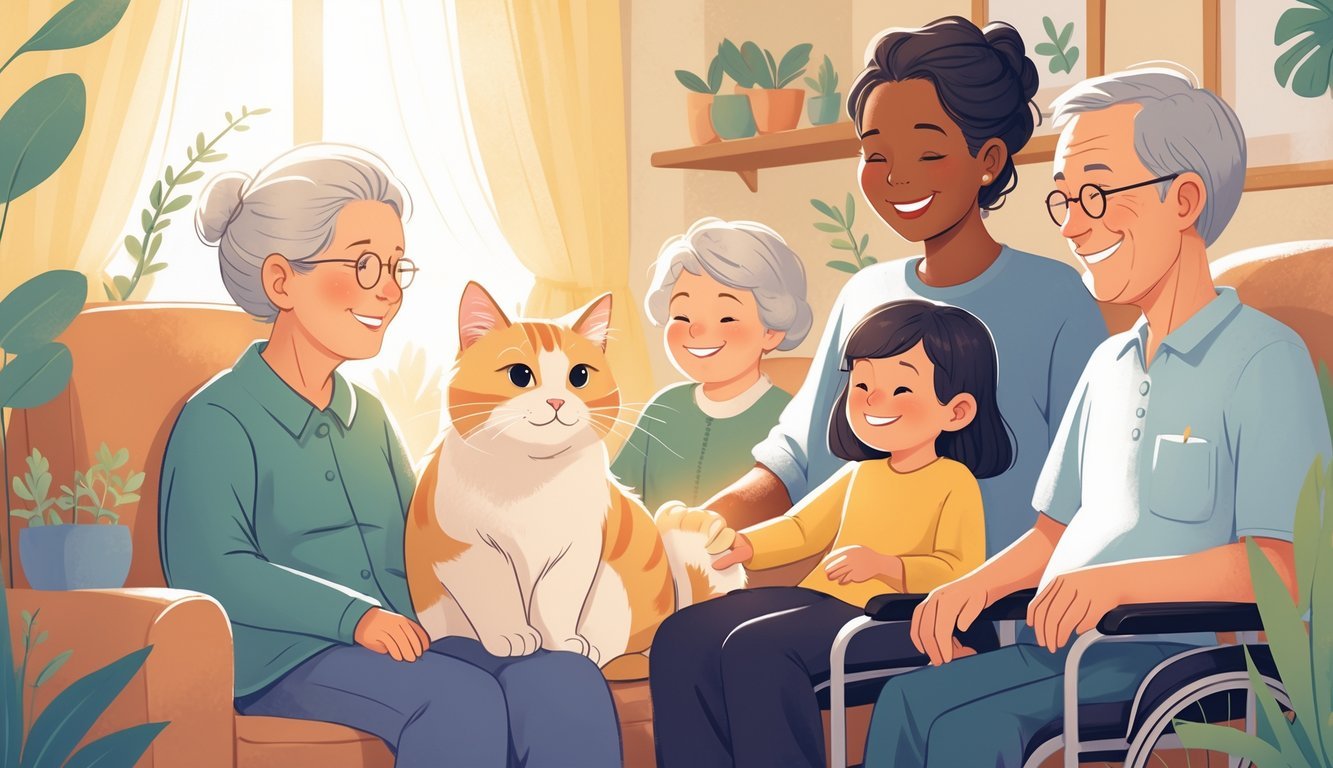PsychNewsDaily Publishers
100 Summit Drive
Burlington, MA, 01803
Telephone: (320) 349-2484
PsychNewsDaily Publishers
100 Summit Drive
Burlington, MA, 01803
Telephone: (320) 349-2484
Therapy cats provide emotional support by reducing anxiety and loneliness, improving mood, and enhancing physical health through calming interactions and companionship in various therapeutic settings.

Most folks picture dogs when someone mentions therapy animals, but honestly, cats can be just as comforting. Cats offer emotional support by easing anxiety and loneliness with their gentle, calming presence. If you want a quiet companion to help you handle stress, a therapy cat could be a surprisingly good fit.

Cats connect with people in their own special way. They’re pretty social and enjoy soft attention, so they’re good at helping folks relax.
Unlike dogs, cats don’t need a lot of space or constant activity. That makes them a practical choice for a lot of people.
Therapy cats have even improved moods and helped with physical health by lowering blood pressure. If you’re hoping for a furry friend to brighten your day or support your mental health, cats can offer real, simple help.

Cats have some traits that just make people feel better. Their calm personalities, social skills, and ability to bond closely really matter if you’re considering a therapy animal.
It helps to know how therapy cats aren’t quite the same as emotional support animals, too.
Therapy cats usually have friendly, gentle temperaments. They like being around people and stay calm even in busy or new places.
That means they can visit hospitals, schools, or care homes and handle it just fine.
These cats often seek out attention and tolerate handling without fuss. Their playful but mellow vibe can help ease anxiety and loneliness.
If you’re searching for a feline friend to help with emotional struggles, look for a cat that’s social, patient, and okay with being touched.
Both therapy cats and emotional support animals (ESAs) give comfort, but their jobs aren’t the same. Therapy cats usually visit public places as part of animal-assisted therapy programs, so they help lots of people.
ESAs, on the other hand, usually live with one person and help with specific emotional or psychiatric needs.
You don’t need a doctor’s note for a therapy cat, but ESAs do require a letter from a mental health professional. Therapy cats get trained to behave calmly around strangers, while ESAs mostly stick by their owner’s side.
The bond between you and a therapy cat can feel powerful. Cats seem to sense your mood and respond with affection, which can lower stress and lift your spirits.
This connection stands out because cats show care in subtle ways—maybe a soft purr or a gentle head bump.
When you spend time with therapy cats, you might notice you feel calmer and more comfortable. This bond makes therapy cats valuable in animal-assisted therapy, where their presence adds to healing through companionship and emotional support.

Cats can really help both your mind and your body. They offer comfort during hard times and can fit into all sorts of places where people need support.
It’s worth understanding how cats work as therapy animals to see their value in health and emotional care.
Having a therapy cat around can ease feelings of depression and anxiety. Their calm presence just helps you relax and feel less alone.
Petting a cat lowers stress and can even boost your mood, making tough days a little easier.
Cats can also help you connect with others, especially if socializing feels hard. Therapy cats create a safe space where you can feel more emotionally stable.
They often become part of mental health therapy, supporting treatment plans from your mental health provider.
Caring for a cat can build self-esteem, too. You get a routine, a sense of purpose, and a little more structure—important things when you’re coping with anxiety or loneliness.
Therapy cats can improve your physical health in a few ways. Just being around them often lowers blood pressure and heart rate, which is good for your heart.
People with limited mobility or chronic pain find gentle distraction and comfort in therapy cats. They help reduce pain and encourage relaxation, which can make life feel a bit better.
The calming effect of a cat’s purr can help you sleep better and lower stress hormones. That combo helps you stay healthier and more balanced, even when you’re dealing with health issues and tough emotions.
You might spot therapy cats in nursing homes, hospitals, schools, prisons, and care homes. In nursing homes, they ease loneliness and bring comfort to residents who don’t get many visitors.
Hospitals use therapy cats to help patients manage fear and pain, giving them a break from medical stress.
Therapy cats also work well in schools, where they can reduce anxiety and help kids build social skills.
These animals create calm, safe environments and help improve the mood all around. Their presence supports animal-assisted activities that fit into different treatment plans and daily life.
Training a therapy cat isn’t like regular pet training. Cats start with basic training to get used to being handled by lots of people in different places.
They learn to stay calm around strangers and deal with noisy settings. This makes them more social and tolerant, both important for therapy work.
Some therapy cats even get certified as pet partners. They go through evaluations to make sure their temperament fits emotional support and therapy roles.
That way, they can safely and effectively help during animal-assisted therapy sessions.

Thinking about adopting or training a therapy cat? Here’s a quick rundown on what you’ll need, which breeds often work best, and how therapy cats support mental health. There’s also info on registering your cat as a therapy animal.
Start by finding a calm, friendly cat who likes being around people.
The cat should pass basic health checks. You’ll probably need to work with a therapy animal group to do evaluations and certifications.
Check with local animal shelters or therapy animal organizations.
You can also look online for certified training programs or ask your vet for suggestions.
Breeds with calm and gentle personalities work best.
Ragdolls, Persians, and Maine Coons are popular picks since they’re usually patient and friendly.
Spending time with a therapy cat can ease stress.
Petting and playing with a cat lowers your heart rate and helps your body release calming hormones.
Yes, lots of people feel less lonely and more relaxed with therapy cats around.
They bring comfort and help distract from tough thoughts.
You can’t actually register a therapy cat the same way people register service animals.
Still, some organizations will certify your cat after you both complete their training and testing.